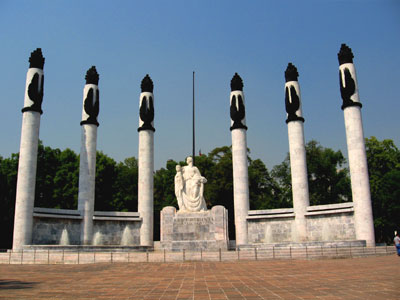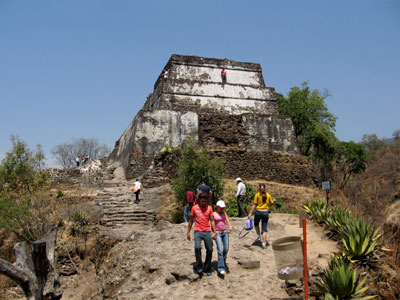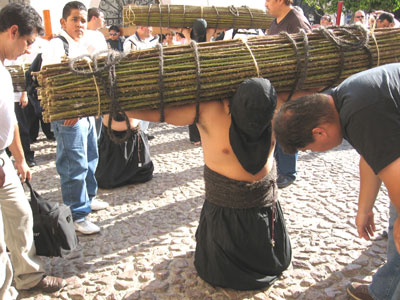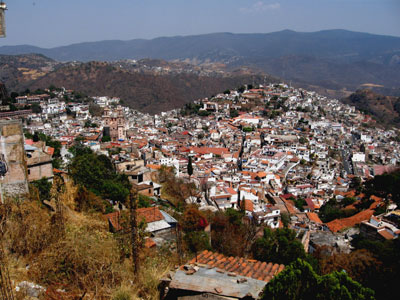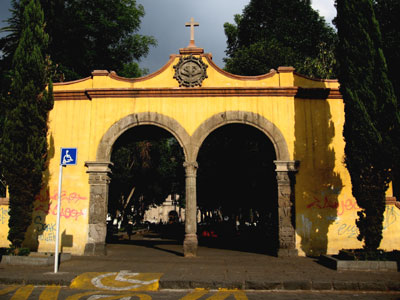This morning another wonderful Mexican breakfast was in store: Vanessa had made “tlacoyos con nopales“ (fried dough covered with fruits of the prickly pear cactus and melted cheese on top) which I really enjoyed. Around 9:30 we got going and Vanessa’s sister dropped us off, right in front of the Angel de la Independencia, a monument erected in 1910 to commemorate independence from Spain, on the Paseo de la Reforma.
The Paseo de la Reforma is an almost 4 km long tree-lined boulevard, connecting the center of the city with the Bosque de Chapúltepec. Various monuments adorn its glorietas, or traffic circles, and we had already seen one of the monuments, the Caballito, yesterday.
Right next to the Angel de la Independencia, an officer of the tourist police stopped us and asked us where we were going and if he could be of help. He was a very charming young man and pulled a laminated map out of his security jacket and pointed out all the major sights in Mexico City. We had seen quite a bit, but inevitably we were going to miss quite a lot as well since there was so much to see and there just was not enough time.
After a photo op with the tourist policeman we headed on and kept exploring the Paseo de la Reforma. From the Angel de la Independencia we continued on to the Diana Cazadora (Diana the Huntress) statue, which caused quite a stir when it was originally unveiled since it is a statue of a naked woman. The city authorities decided to cover up the statue for a while, but sanity prevailed and the shameful covers were removed after some time.

Diana Cazadora
We continued our mid-morning stroll towards the Bosque de Chapúltepec, a former sacred ground for the Pre-Colombian cultures and now Mexico City’s biggest park. Walking up to the castle, you first encounter a big monument called the Monumento a los Niños Héroes, commemorating the army cadets (the “boy heroes”) who died defending the castle from an American attack in 1847.
From there we explored the Castillo de Chapúltepec, which was originally built in the 1760s, but is most well-known for having being the residence of the unfortunate Austrian-born emperor Maximillian, and his wife Princess Charlotte, who only governed Mexico for a few short years until 1866 when he found an unfortunate end by firing squad.

The Monumento a los Niños Heroes
We slowly strolled up the castle hill, paid our entrance fee and started exploring the castle. In true Habsburg tradition, it is furnished with ornate, baroque style furniture, and the first thing you see are the royal “carrozas” (carriages) when you come into the first hall of the exhibition. From that point onwards you see a variety of rooms as they were used by the Habsburg monarchs – dining rooms, living rooms, a bedroom as well as a meeting room, that illustrate the extreme opulence that these royals enjoyed. No wonder the population, who was merely scraping by, got upset with the dominance and privilege of the aristocrats.
We then walked to the top level garden which is enclosed by glass windows. Right next to one of these glass walls on the ground we noticed a tiny “colibri” (hummingbird) that had flown against the glass enclosure and knocked itself out. Vanessa rescued it by taking it gently in her hand, we then walked downstairs and Vanessa set the tiny bird free on the grass. When she opened her hand, the bird had regained its wits enough to fly away back into freedom.

Wonderful views from the Castillo de Chapultepec
Then we explored the Museo del Caracol (the “Snail Museum”, due to its shape), which also holds a museum on the history of Mexico (Galeria de Historia), featuring a series of dioramas depicting scenes from the fight for independence to the Mexican Revolution.
The view over the city from the castle hill is astounding and you literally enjoy a 360 degree panorama. Then we walked down the hill, past a whole series of street vendors, selling everything from Mexican snacks, to sun hats and visors, to disposable cameras, much of which is announced by promotionally shouting out the assortment of merchandise to the parade of visitors.
The Lago Chapúltepec is a popular weekend destination for Mexican families and features rowboats, swans, stages for theatre and ballet presentations and many beautiful spots to relax. We explored the Casa del Lago, an art centre run by Mexico’s largest university, the UNAM. Right in front of the Casa del Lago people of all ages were painting, drawing, reading newspapers, and this location offers many free artistic and cultural activities to the local population.

Art in the Parque de Chapultepec
Just after our visit we continued walking on the walkway with all the street vendors and saw a local artist who was producing miniature paintings, using his fingers, his fingertips, and the occasional brush stroke. He produced a variety of landscapes, including one with the well-known Mexican volcano Popocatépetl. I had a chance to take a video of his artistic endeavours and ended up buying 3 very colourful miniature paintings depicting typical Mexican scenes. While he was painting he was telling stories about the themes he was painting, and he cracked the occasional joke, which made the entire crowd of onlookers laugh.
Then we headed back onto the Paseo de la Reforma towards the Auditorio, Mexico City’s famous outdoor concert facility. On the sidewalk beside the busy 6-lane road, there was a public art project: a whole series of life-sized cows that had been painted and decorated in very unique ways and provided great photo opportunities for the enthusiastic visitors. This public art campaign reminded me of Toronto’s moose exhibits from a few years ago. I believe Chicago had a similar campaign with cows as well.

Public art featuring cows
Once arrived at the Auditorio we purchased a refreshing “nieve” (crushed ice, in this case flavoured with lime) and walked back on the Paseo de la Reforma towards the famous Museo de la Antropología. We explored the outside and the lobby, unfortunately we did not have enough time to explore the inside. The Museo de la Antropologia is one of the most famous and most extensive museums in Mexico. It was opened in 1964 and has various collections of artifacts from Mexico’s various pre-Columbian cultures. Right outside the museum is a huge stone statue of the rain god Tlaloc.
Then we took a bus (a ”pesera”) to the another part of the Bosque de Chapúltepec, close to the Lago Mayor, where we exited near the Children’s Museum and started exploring this portion of this huge park. We were in search of the restaurant overlooking Lago Mayor and had a bit of a hard time finding it first, since there is a Restaurante del Lago and a Café del Lago. Finally after Vanessa had asked several passers-by, we figured out we had to go to the Café del Lago and sure enough we found our lunch destination. The Café is an attractive looking structure overlooking the lake, and it features a buffet lunch every day. Fortunately we negotiated our way into just ordering a soup since we had already snacked on “chicharrones” (usually puffed and fried pork rinds, but these ones were made of wheat flour) and there was no way we could handle a full meal. I simply had a delicious chile poblano, a green soup made of chili peppers that was very tasty and creamy.

In front of the Tlaloc next to the Museo de Antropologia
Then we made our way back onto the road where we hopped onto another “pesera” that would take us to the subway station at Los Constituyentes, where we descended about 3 or 4 major staircases downwards (we must have been about 40 or 50 meters below the surface) and caught three subway trains back into Vanessa’s neighbourhood. After a quick and inexpensive stint (5 pesos, 70 cents) in an Internet café, Vanessa’s parents and her sister picked us up to take us to San Angel, another beautiful neighbourhood in Mexico City with colonial buildings and cobble-stoned streets.
We started by exploring the Iglesia de San Jacinto, which features an inner courtyard with a rain chute to capture rain water, and a beautiful enclosed private garden in the back of the church. Inside a big festivity was taking place: a “quinceñera” – a ritual celebrating a 15-year-old girl’s entry into adulthood. Then we explored the Plaza San Jacinto which had hundreds of street vendors, selling different types of artwork. San Angel is known as a city district that is home to many artists. It features numerous permanent galleries as well as the weekend “tianguis” or “mercado ambulante” (“walking market”) with vendors that set up shop only on the weekend.

Quinceñera celebration
For dinner we picked one of the restaurants overlooking the square and had some traditional Mexican dishes. I had a “sopa de la fonda” (chicken soup with pico de gallo and avocado) followed by an “ensalada de berros” (watercress salad with diced tomatoes, onions and bacon). Vanessa’s family had a variety of seafood dishes and “chile relleno” (chili peppers stuffed with minced meat, covered with a sauce made of cream, nuts and cinnamon).
At about 8 pm we had finished our dinner and since we had had a pretty exhausting day we headed back to catch up on some sleep and rest up for our departure day.
